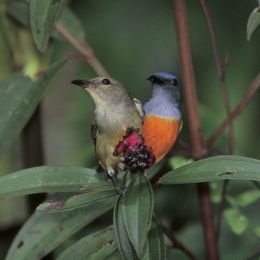Flowerpeckers are tiny birds that dart around the forest trees with lightning speed. Because of the rapid movement and being solitary birds, they are difficult to see. However, they always make their characteristic metallic clicking sound and with a little patience, the location of these birds can always be pinpointed.
The Orange-bellied (Dicaeum trigonostigma) (male and female, above left) and Scarlet-backed (D. cruentatum) (male, above right) are found locally and easily seen but one needs to travel to Peninsular Malaysia to view the Crimson-breasted (Prionochilus percussus) (male, below). All three species of flowerpeckers shown here are feasting on melastoma fruits.
The birds take flower nectar, fruits and occasionally small insects. Figs are a favourite, as well as the berries of the sun-loving shrub, melastoma (Melastoma malabathricum). It is easier to view these birds around melastome as fruiting is throughout the year. On a sunny spell, the metallic clicking of these birds can be heard, heralding their presence.
Melastoma, sometimes misleadingly called Singapore rhododendron, is a weedy shrub that proliferates in disturbed areas. In areas that are fired regularly, these plants soon form semi-pure stands as they survive the fire while others do not. If left alone, they grow into small trees.
The plant flowers throughout the year. The pinkish mauve flowers last only a day, opening early morning and closing late afternoon. They attract bees, especially the large carpenter bees that assist in pollination.
The fruits split open at maturity to expose the soft, dark blue pulp dotted with tiny, orange seeds. They are sweetish and children love them, staining their teeth purple in the process of eating them. Squirrels, monkeys and birds love them, and in the process help to disperse the seeds.
Morten Strange & YC Wee
Singapore
February 2008
Images from the book “A Passion for Birds” courtesy of Ong Kiem Sian.













7 Responses
lovely shots.
VERY interesting! I never even knew these birds existed.
beside the flowerpecker, I have seen yellow-vented bulbul and tree shrew feeding on the berries of melastoma (senduduk) in front of my parent’s house where i used to park my car.
I like it when people get together and share views. Great site,
stick with it!
As the saying goes, knowledge not shared (when stored in your fading memory or hard disk) is knowledge lost.